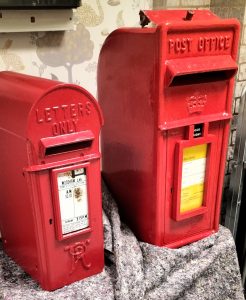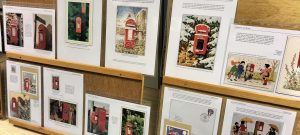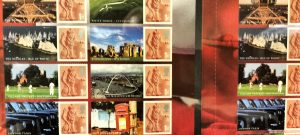On 1st April Banbury were entertained by Wayne Cox who spoke on the subject of UK post boxes. His display was in two halves.
The first half he titled “small but perfectly formed – the lamp letter box”. Lamp letter boxes are small post boxes which are normally attached to a pole or lamppost. They are commonplace features in both towns and villages.

Wayne explained that in Britain in the 1890’s we only had pillar boxes which were expensive to produce and install. Folk in London’s residential squares found it a bind to walk some distance to a postbox so lobbied for the introduction of alternatives. In order to help Royal Mail introduced smaller boxes built into walls and mounted on lampposts and telegraph poles.
Wayne illustrated his talk with philatelic material and photographs of the many varieties of lamp letter boxes used in the UK along with two real example which he carried into the community centre. He explained that they were not a success in urban areas as they filled up too quickly but were widely used in remote rural areas where the quantity of post was smaller, they are thus particularly popular in the Hebrides. He also explained that they are prone damage and to theft by metal thieves and “collectors” so some examples are now quite rare.
The second half Wayne titled “pillars of the community – the first 100 years of British pillar boxes”. He explained that originally letters had to be posted at a post office and that this led to large unruly crowds gathering at posting times. The author Anthony Trollope whilst employed by Royal Mail in the Channel Islands suggested the introduction of roadside pillar boxes and in 1852 the first one was installed in St Hellier. It no longer survives but one installed in 1853 in Guernsey does and is the oldest box in the British Isles.
The experiment proved to be a great success and they were introduced throughout the UK. However, each portal district was responsible for their design and installation. This led to a plethora of designs some of which are very distinct and attractive. After 1859 a national standard was introduced designed by Andrew Tilly. They were attractive hexagonal boxes based upon the ancient Greek Temple of the Winds in Athens. About 100 exist today and are still in use.
In 1894 central government produced a more robust but stripped down design. By the time George V became king the design that we recognize became commonplace.
Wayne also referred to one last change. When the first Queen Elizabeth II box was installed in Edinburgh it caused uproar because she was only Queen Elizabeth I of Scotland. The box was vandalized and ultimately blown up ! Royal mail responded by removing the royal cypher from all subsequent boxes installed in Scotland and replacing it with a Scottish crown which remains in use to this day.
His talk was illustrated by stamps, artwork, postcards, newspapers and cigarette cards, all showing the boxes and incidents he referred to.


The club thanked Wayne for a most unusual and interesting display.
Our next meeting will be on Tuesday 15th April when John Biddlecombe will talk on New Zealand Health Stamps & The Pigeon Post. Meet at 7:30pm at Hanwell Fields Community Centre. The Banbury Stamp Society is on-line at ‘www.banburystampsociety.co.uk’, or contact John Davies on 01295 255831. All are welcome.